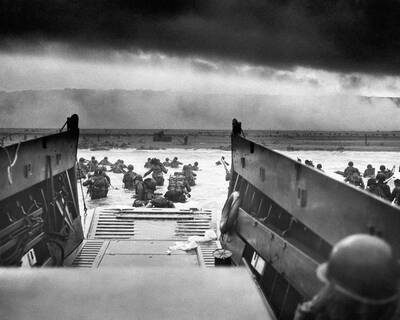Smith, the bisexual Southern California college student whose misadventures — some possibly in his own head, many in other people’s beds — are at the center of Kaboom, is a cinema studies major. This fact in itself may not be enough to establish him as an alter ego for the director, Gregg Araki, but it does allow Araki to offer some hints about what he is up to in this chaotic, trifling, oddly likable film.
At one point Araki’s super-bright color scheme gives way to flickering black-and-white images culled from the early, silent, aggressively surrealist work of Luis Bunuel. Bunuel’s insight in L’Age d’Or and Un Chien Andalou — independently repeated a few years later by Leo McCarey in the Marx Brothers vehicle Duck Soup — was that the syntax of film could make the incongruous appear coherent. An illusion of continuity is produced that can turn nonsense into sense, even as the medium’s compression and fracturing of time can have the opposite effect.
And Araki works the logic both ways. Kaboom is both crazily disjunctive and smooth, jumping from polymorphous sex comedy to murder mystery to paranoid apocalyptic science fiction freak-out, with nimble nonchalance and up-to-the-minute pop music cues. As Smith (Thomas Dekker) and his best friend, Stella (Haley Bennett), trade sarcastic banter and exercise their late-adolescent libidos, weird things start to happen. Strangers whom Smith has seen in dreams show up at parties. Shadowy figures in animal masks commit grotesque acts of violence that leave behind no evidence. Stella’s lover, Lorelei (Roxane Mesquida), turns out to have supernatural powers, which come in handy during sex but turn scary once Stella tries to cool things down a little.

Photo courtesy of CatchPlay
So there is the stalker-witch-lesbian spoke of the narrative, which ultimately joins — haphazardly and almost facetiously, true to the movie’s governing spirit — a bunch of others. Smith lusts after his roommate Thor (Chris Zylka), a hunky, blond, clothing-optional surfer who is avowedly heterosexual but whose behavior illustrates the axiom that “straight guys are gayer than gay guys.” This wisdom is offered by London (Juno Temple), a pixieish adventuress who becomes Smith’s frequent bedfellow and might almost be mistaken, if Kaboom allowed such conventional terms, for his girlfriend.
Smith is also picked up by a stud on the beach, courted by a sweet nerd named Oliver, and more and more obsessed with his strange visions. To say that the various loose ends are gathered up in the end is accurate enough, but really beside the point. Araki is not trying to harmonize the disparate elements of campus soap opera, soft-porn farce, serial-killer thriller and (what was it again?) apocalyptic science fiction freak-out, but rather to shake them all together until they explode.
Several characters say they feel the world is coming to an end, a signal that the movie is accelerating toward its own conclusion. Which raises, in the viewer’s mind, the usual question: bang or whimper? A little of both, really, but mostly a hollow pop, like a Champagne bottle party favor filled with confetti. And this, too, is part of the point. It would be silly to fault Kaboom for being shallow or unserious; its whole mode of being is profoundly anti-serious, playfully assaulting any form of earnestness other than Smith’s emo melancholy.
But there is also a peculiar undercurrent of nostalgia. In the 1990s Araki made his reputation on a series of films that pushed sexual freedom and youthful rebellion to the point of nihilism. Their titles — The Living End, The Doom Generation, Nowhere and Totally Fucked Up — evoke the basic attitude, if not the full measure, of Araki’s furious wit. Kaboom, following the somber, beautiful drama of Mysterious Skin and the relaxed goofiness of Smiley Face, represents the director’s desire to get back in touch with his old, bad boy self.
Who wouldn’t want to? Then again, who can? Kaboom has some of the passionate awkwardness of a punk-band reunion tour. But there is something forced and inauthentic about the way the film throws itself at its characters, a bunch of smart, randy, uninhibited kids who frolic like rabbits and talk like junior semioticians. Those kids are all right — and cute as can be — but what about the guy with the camera who’s always following them around? Is he the too-hip junior professor, or another sad, aging graduate student checking the mirror to reassure himself that he’s really still young, and still cool?

Taiwan is one of the world’s greatest per-capita consumers of seafood. Whereas the average human is thought to eat around 20kg of seafood per year, each Taiwanese gets through 27kg to 35kg of ocean delicacies annually, depending on which source you find most credible. Given the ubiquity of dishes like oyster omelet (蚵仔煎) and milkfish soup (虱目魚湯), the higher estimate may well be correct. By global standards, let alone local consumption patterns, I’m not much of a seafood fan. It’s not just a matter of taste, although that’s part of it. What I’ve read about the environmental impact of the

It is jarring how differently Taiwan’s politics is portrayed in the international press compared to the local Chinese-language press. Viewed from abroad, Taiwan is seen as a geopolitical hotspot, or “The Most Dangerous Place on Earth,” as the Economist once blazoned across their cover. Meanwhile, tasked with facing down those existential threats, Taiwan’s leaders are dying their hair pink. These include former president Tsai Ing-wen (蔡英文), Vice President Hsiao Bi-khim (蕭美琴) and Kaohsiung Mayor Chen Chi-mai (陳其邁), among others. They are demonstrating what big fans they are of South Korean K-pop sensations Blackpink ahead of their concerts this weekend in Kaohsiung.

Oct 20 to Oct 26 After a day of fighting, the Japanese Army’s Second Division was resting when a curious delegation of two Scotsmen and 19 Taiwanese approached their camp. It was Oct. 20, 1895, and the troops had reached Taiye Village (太爺庄) in today’s Hunei District (湖內), Kaohsiung, just 10km away from their final target of Tainan. Led by Presbyterian missionaries Thomas Barclay and Duncan Ferguson, the group informed the Japanese that resistance leader Liu Yung-fu (劉永福) had fled to China the previous night, leaving his Black Flag Army fighters behind and the city in chaos. On behalf of the

The captain of the giant Royal Navy battleship called his officers together to give them a first morsel of one of World War II’s most closely guarded secrets: Prepare yourselves, he said, for “an extremely important task.” “Speculations abound,” one of the officers wrote in his diary that day — June 2, 1944. “Some say a second front, some say we are to escort the Soviets, or doing something else around Iceland. No one is allowed ashore.” The secret was D-Day — the June 6, 1944, invasion of Nazi-occupied France with the world’s largest-ever sea, land and air armada. It punctured Adolf